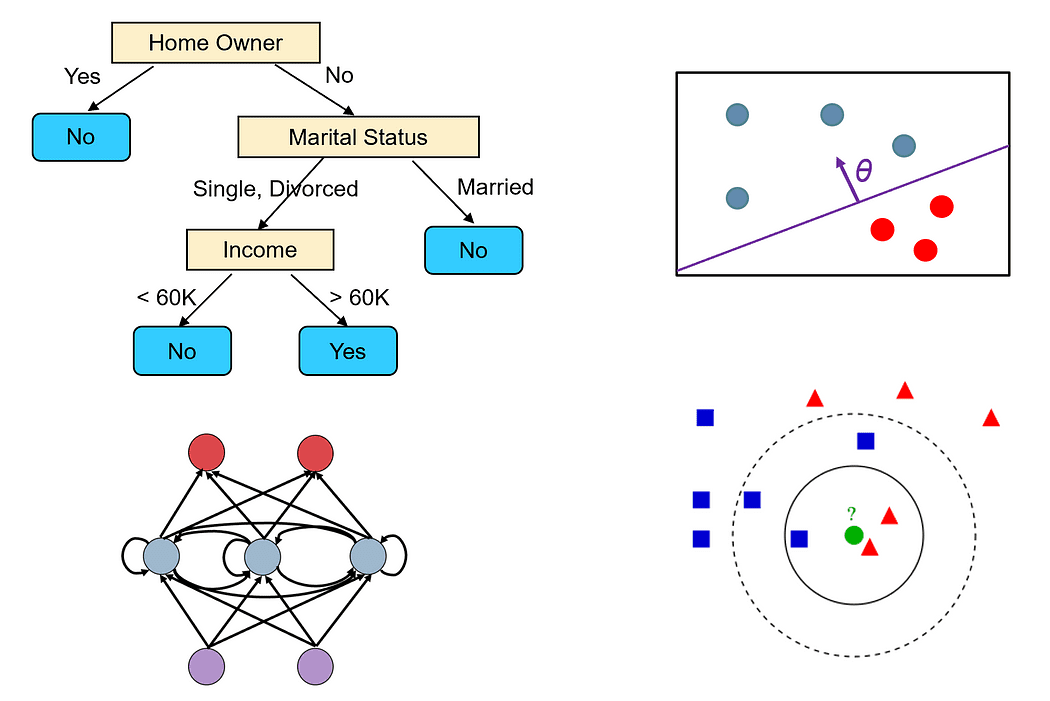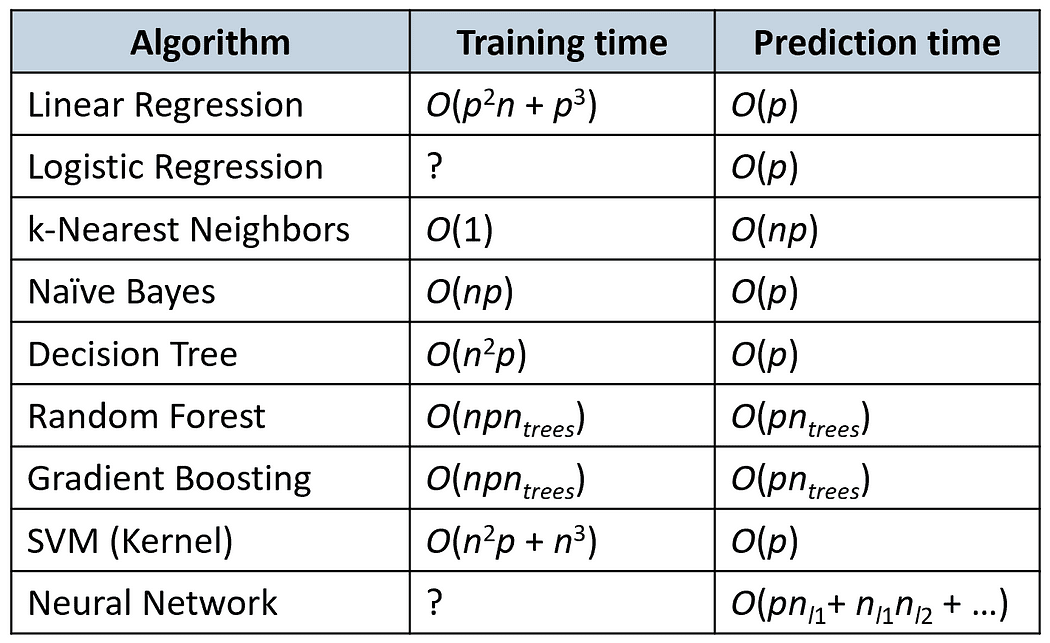One of the key decisions you need to make when solving a data science problem is
which machine learning algorithm to use.
There are hundreds of machine learning algorithms to choose from, each with its own
advantages and disadvantages. Some algorithms may work better than others on specific
types of problems or on specific data sets.
The “No Free Lunch” (NFL) theorem states that there
is no one algorithm that works best for every problem, or in other words, all algorithms
have the same performance when their performance is averaged over all the possible
problems.

Different machine learning models
In this article, we will discuss the main points you should consider when choosing a
model for your problem and how to compare different machine learning algorithms.
Key Algorithm Aspects
The following list contains 10 questions you may ask yourself when considering a specific
machine-learning algorithm:
Which type of problems can the algorithm solve? Can the
algorithm solve only
regression or classification problems, or can it solve both? Can it handle
multi-class/multi-label problems or only binary classification problems?
Does the algorithm have any assumptions about the data set?
For example, some
algorithms assume that the data is linearly separable (e.g., perceptron or linear
SVM), while others assume that the data is normally distributed (e.g., Gaussian
Mixture Models).
Are there any guarantees about the performance of the
algorithm? For example, if the
algorithm tries to solve an optimization problem (as in logistic regression or
neural networks), is it guaranteed to find the global optimum or only a local
optimum solution?
How much data is needed to train the model effectively? Some
algorithms, like deep
neural networks, are more data-savvy than others.
Does the algorithm tend to overfit? If so, does the algorithm
provide ways to deal
with overfitting?
What are the runtime and memory requirements of the algorithm,
both during training
and prediction time?
Which data preprocessing steps are required to prepare the
data for the algorithm?
How many hyperparameters does the algorithm have? Algorithms
that have a lot of
hyperparameters take more time to train and tune.
Can the results of the algorithm be easily interpreted? In
many problem domains
(such as medical diagnosis), we would like to be able to explain the model’s
predictions in human terms. Some models can be easily visualized (such as decision
trees), while others behave more like a black box (e.g., neural networks).
Does the algorithm support online (incremental) learning,
i.e., can we train it on
additional samples without rebuilding the model from scratch?
Algorithm Comparison Example
For example, let’s take two of the most popular algorithms: decision trees and neural networks, and compare them
according to the above criteria.
Decision Trees
Decision trees can handle both classification and regression
problems. They
can also easily handle multi-class and multi-label problems.
Decision tree algorithms do not have any specific assumptions
about the data
set.
A decision tree is built using a greedy algorithm, which is
not guaranteed
to find the optimal tree (i.e., the tree that minimizes the number of tests
required to classify all the training samples correctly). However, a
decision tree can achieve 100% accuracy on the training set if we keep
extending its nodes until all the samples in the leaf nodes belong to the
same class. Such trees are usually not good predictors, as they overfit the
noise in the training set.
Decision trees can work well even on small or medium-sized
data sets.
Decision trees can easily overfit. However, we can reduce
overfitting by
using tree pruning. We can also use ensemble methods such as random
forests that combine the output of multiple decision trees. These methods
suffer less from overfitting.
The time to build a decision tree
is O(n²p), where n is the number of
training samples, and p is the number of features. The
prediction time in decision trees depends on the height of the tree, which
is usually logarithmic in n, since most decision trees are
fairly balanced.
Decision trees do not require any data preprocessing. They can
seamlessly
handle different types of features, including numerical and categorical
features. They also do not require normalization of the data.
Decision trees have several key hyperparameters that need to
be tuned,
especially if you are using pruning, such as the maximum depth of the tree
and which impurity measure to use to decide how to split the nodes.
Decision trees are simple to understand and interpret, and we
can easily
visualize them (unless the tree is very large).
Decision trees cannot be easily modified to take into account
new training
samples since small changes in the data set can cause large changes in the
topology of the tree.
Neural Networks
Neural networks are one of the most general and flexible
machine learning
models that exist. They can solve almost any type of problem, including
classification, regression, time series analysis, automatic content
generation, etc.
Neural networks do not have assumptions about the data set,
but the data
needs to be normalized.
Neural networks are trained using gradient descent. Thus, they
can only find
a local optimum solution. However, there are various techniques that can be
used to avoid getting stuck in local minima, such as momentum and adaptive
learning rates.
Deep neural nets require a lot of data to train in the order
of millions of
sample points. In general, the larger the network is (the more layers and
neurons it has), more we need data to train it.
Networks that are too large might memorize all the training
samples and not
generalize well. For many problems, you can start from a small network
(e.g., with only one or two hidden layers) and gradually increase its size
until you start overfitting the training set. You can also add regularization in order to deal
with overfitting.
The training time of a neural network depends on many factors
(the size of
the network, the number of gradient descent iterations needed to train it,
etc.). However, prediction time is very fast since we only need to do one
forward pass over the network to get the label.
Neural networks require all the features to be numerical and
normalized.
Neural networks have a lot of hyperparameters that need to be
tuned, such as
the number of layers, the number of neurons in each layer, which activation
function to use, the learning rate, etc.
The predictions of neural networks are hard to interpret as
they are based
on the computation of a large number of neurons, each of which has only a
small contribution to the final prediction.
Neural networks can easily adapt to include additional
training samples, as
they use an incremental learning algorithm (stochastic gradient descent).
Time Complexity
The following table compares the training and prediction times of some
popular algorithms (n is the number of training samples
and p is the number of features).

Most Successful Algorithms in Kaggle Competitions
According to a survey that was done in 2016, the most frequently used
algorithms by Kaggle competition winners were gradient boosting
algorithms (XGBoost) and neural networks (see this article).
Amongst the 29 Kaggle competition winners in 2015, 8 of them used
XGBoost, 9 used deep neural nets, and 11 used an ensemble of both.
XGBoost was mainly used in problems that dealt with structured data
(e.g., relational tables), whereas neural networks were more successful
in handling unstructured problems (e.g., problems that deal with image,
voice, or text).
It would be interesting to check if this is still the situation today or
whether the trends have changed (is anyone up for the challenge?)
Thanks for reading!
Author: Dr Roi Yehoshua



